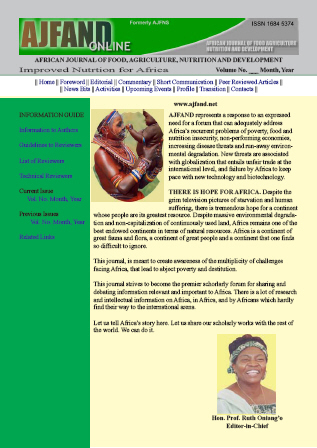
|
African Journal of Food, Agriculture, Nutrition and Development
Rural Outreach Program
ISSN: 1684-5358
EISSN: 1684-5358
Vol. 12, No. 4, 2012
|
 Bioline Code: nd12047
Bioline Code: nd12047
Full paper language: English
Document type: Research Article
Document available free of charge
|
|
|
African Journal of Food, Agriculture, Nutrition and Development, Vol. 12, No. 4, 2012
| en |
IMPLEMENTATION OF THE NEW WHO RECOMMENDATIONS ON HIV AND INFANT FEEDING: CHALLENGES AND THE WAY FORWARD
Sagoe-Moses, C; Mwinga, K; Habimana, P; Toure, ID & Ketsela, T
Abstract
Breast milk provides all the nutrient needs of the infant especially in the first six months of life and also protects the growing infant from pneumonia, diarrhoea, and malnutrition, which are the major causes of morbidity and mortality in the African Region. However breastfeeding is also known to transmit the Human Immuno- deficiency Virus (HIV) from mother to the child. Several guidelines have been developed to guide policy makers, health workers and mothers on the most appropriate methods to feed HIV exposed infants. Previous HIV and infant feeding guidelines emphasized on preventing infants from becoming infected with HIV by counseling HIV-infected mothers to avoid all breastfeeding. Over the period, programme implementers and researchers have reported difficulties in implementing earlier recommendations and guidelines on HIV and infant feeding within health-care systems. New evidence now shows that giving Anti-Retroviral therapy (ARVs) to either the HIV-infected mother or HIV-exposed infant can significantly reduce the risk of transmitting HIV through breastfeeding. Thus, in 2010 World Health Organization (WHO) issued the latest guidelines on HIV and infant feeding entitled Principles and recommendations for infant feeding in the context of HIV and a summary of evidence. The 2010 WHO guidelines have changed the recommendations on how HIV infected mothers should feed their infants, and how health workers should support them. National authorities in each country can decide which infant feeding practice will be primarily promoted and supported by Maternal and Child Health services, i.e. breastfeeding with an antiretroviral intervention to reduce transmission or avoidance of all breastfeeding. Previous guidelines and recommendations on infant feeding in the context of HIV have undergone frequent changes over the past decade. The adaptation and implementation of previous and current guidelines at national level have met challenges. These include lack of consensus among key stakeholders, inadequate funding for the additional cost of providing ARVs to the mother or the child and difficulties in communicating the recommendations in the new guidelines clearly to mothers, health workers and policy makers. To address these challenges a number of proposals have been suggested such as coordinated consensus building process, costing of interventions and a phased implementation approach to ensure successful scale up over time. This paper describes the process of adapting global HIV and infant feeding recommendations and guidelines at national level. It also reviews the challenges encountered in implementation and proposes the way forward in addressing them.
Keywords
WHO HIV Infant, Feeding, Recommendations
|
| |
© Copyright 2012 - African Scholarly Science Communications Trust
Alternative site location: http://www.ajfand.net/
|
|
